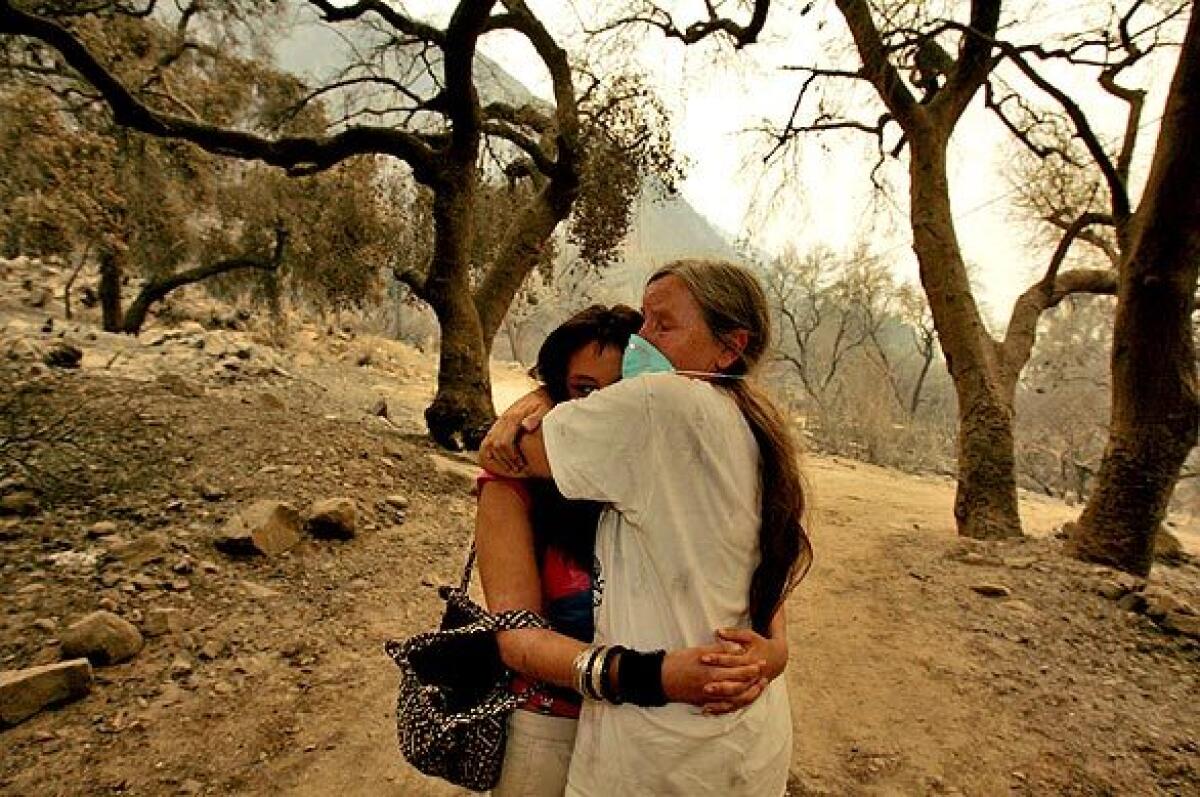Report cites poor communications, flawed decisions in two Station fire deaths

- Share via
A lack of communications with commanders and tactical decisions that now seem flawed probably contributed to the deaths of two firefighters killed while trying to defend their mountaintop camp during last summer’s huge Station blaze, a multiagency inquiry has found.
In a report to the Board of Supervisors, the Los Angeles County Fire Department also cites a “perfect storm” of erratic winds and weather-warping heat that drove the flames through Camp 16, a remote outpost in the Angeles National Forest that had been out of touch with commanders managing the Station fire response.
Some of the key findings by the county department, the state Department of Forestry and Fire Protection and other agencies echo elements of a Times article in December that, based on witness accounts and internal records, raised questions about the deaths of Capt. Tedmund “Ted” Hall and Specialist Arnaldo “Arnie” Quinones.
“They were not in contact with the incident commanders -- that’s a fact,” county Fire Chief P. Michael Freeman said of Hall, who was the camp superintendent, and battalion chiefs who approved the plan to protect the mile-high compound.
“If they had been, there would have been better information available.... We’re all regretful. Looking back on everything, hindsight is always 20-20.”
Freeman said there was no way of knowing whether regular communications with commanders would have led to an evacuation of the camp. But he said the department “would do things differently in the future,” such as conducting a more thorough analysis of the danger posed by changing winds and dense brush.
The report labels the poor communications and the related decision to remain at the camp as “causal” factors that, if avoided, “probably would have prevented the incident.”
Hall and Quinones were killed on the afternoon of Aug. 30 when their truck ran off a dirt road below the camp, struck a rock outcropping and flipped onto its roof. The report says the truck went over the side after Hall apparently lost consciousness while trying to drive through towering, fast-advancing flames. He and Quinones had just made an unsuccessful attempt to slow the blaze by setting backfires along the road -- “their last act of courage,” the report says.
In a harrowing passage, the document recounts Hall’s final radio transmission, an instruction to “keep the road clear,” followed by a curse. Minutes earlier, another firefighter who had spotted Hall using a flare-type gun to ignite the backfires radioed him to “get out.... You got fire behind you, you got fire below you.”
The unnamed firefighter repeated his warnings, including by yelling at Hall and blowing a whistle, according to the report. The firefighter told investigators he saw Hall and Quinones move back toward their truck as if to flee the area. The truck was later found hundreds of feet below the road, upside down and on fire.
A converted Nike missile installation, Camp 16 was operated by the county agency and staffed with state inmate firefighters. The camp had not been assigned to the Station fire command, made up of the U.S. Forest Service and county department.
That remained the case even on the fifth day of the fire as the flames roared toward the camp’s perch on Mt. Gleason.
In addition, the report says that nearly six hours before the deaths, a fire-watch helicopter determined that the flames were “a direct threat to the camp,” but that the chopper was unable to make contact with the crews below. The copter relayed the information to the forest dispatch center, but the warning apparently was not forwarded to commanders or the camp, according to the report.
Meanwhile, a “sense of ownership” in the camp might have persuaded Hall and others to stay on Mt. Gleason to confront the fire, despite the blaze’s building intensity and a lone escape route: the mountain road that would become engulfed in flames, the report says.
It also says that no lookout was assigned to alert Hall and Quinones when they braved the flames to set the backfires and that Hall had not completed all mandatory training for conducting such a “firing” operation, although he had years of field experience.
At the same time, the camp crews were communicating on two radio frequencies, hampering coordination.
Nevertheless, the report hails the actions of Hall, Quinones and their colleagues. They were quick to move firefighters from imperiled buildings to the safety of vehicles, the report says. “Cool heads, leadership, split-second decision making, raw courage and sound execution of orders given saved 72 lives that day,” it says.
The Times reported in December that the dispatch logs, other documents and interviews showed the disconnect between the camp and commanders, which experts described as a violation of basic firefighting protocols. Examinations of the deaths have been sensitive, in part because of Times reports that have raised doubts about the Forest Service’s initial response to the fire when it was potentially containable.
According to records and interviews, the agency scaled back its assault at the end of its first day and was slow to act the next morning, canceling or delaying deployments of water-dropping aircraft.
A Forest Service spokeswoman said the agency was still reviewing the Camp 16 report Thursday and could not comment.
An aide to county Supervisor Michael Antonovich, a vocal critic of the Forest Service’s handling of the fire, praised the report as thorough and forthright, but said it “is the latest verification that points to the Forest Service’s failure to extinguish the Station fire in its earliest stages.”
--
More to Read
Sign up for Essential California
The most important California stories and recommendations in your inbox every morning.
You may occasionally receive promotional content from the Los Angeles Times.











